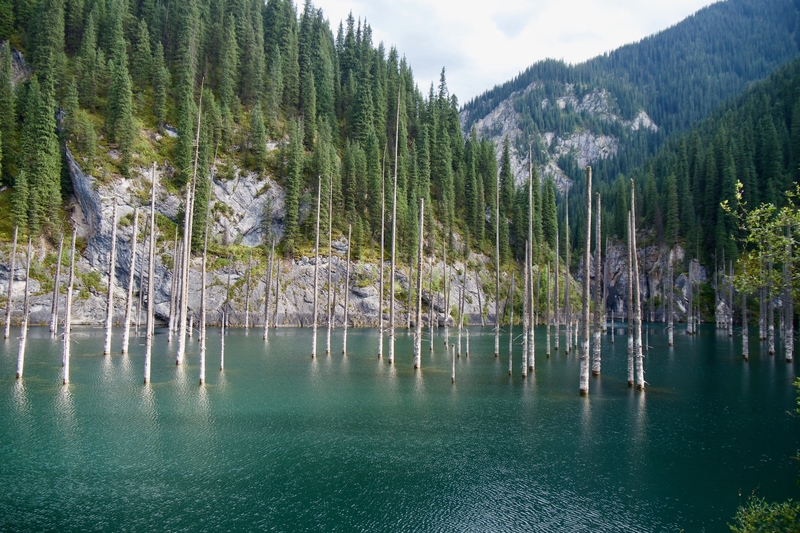
Four Day Kazakhstan Itinerary from Almaty
Though Kazakhstan is one of the largest countries in the world in terms of area, the ex-Soviet republic doesn’t often find itself at the top of peoples’ bucket lists. A massive swath of land that comprises much of Russia’s southern border, Kazakhstan’s name recognition is antonymous to its size. Aside from oil production and Borat, mentions of Kazakhstan often draw blanks stares. As a result, when I told friends and co-workers that I would be visiting Kazakhstan for four days prior to the World Nomad Games in Kyrgyzstan, their answers were always the same: “You’re going to where before you go to the what in where?”
Since Dan and I only had a few days to spare before the World Nomad Games, we didn’t have time to explore the farthest reaches of this vast and off-the-beaten-path country. Instead, we focused our Kazakhstan itinerary on the area around Almaty–Central Asia’s primary gateway and the hub of Kazakhstan’s nascent tourism industry.
Almaty is a conveniently located metropolis that lies along the foot of the Tian Shan Mountains in Southern Kazakhstan. The natural diversity of the city’s surroundings is amazing–from arid deserts and chiseled canyons, to lush valleys and glistening lakes.
Kazakhstan Itinerary Day 1: Almaty
Almaty is Kazakhstan’s most populous city and the location of Central Asia’s largest airport. It is a cosmopolitan city, with wide boulevards, leafy parks, pleasant cafes and unparalleled access to the country’s most beautiful scenery.
Dan and I traveled to Kazakhstan in late August, after spending a few days in Seoul. Within hours of arriving at the Almaty Backpackers, we met up with our friend, Courtney, who had decided to join us on our trip to Central Asia. Together, we spent the first day of our trip exploring Almaty and penning down the remainder of our Kazakhstan itinerary.
Almaty’s main tourist attraction–the yellow and white Zenkov Cathedral– was unfortunately hidden under scaffolding during our visit, so we spent the remainder of our day wandering aimlessly around the city on foot. We strolled along Almaty’s pedestrian streets, found shade in its leafy parks, ate our first bowl of hand-pulled laghman noodles and admired the views of the Tian Shan Mountains.

The highlight of our visit to Almaty was the Green Bazaar–a large, two-level market that thrust us headfirst into the sights and smells of Central Asia. The market is not for the faint of heart. Cow heads and horse carcasses hang from rafters, dripping in blood.
It is smelly, disgusting and utterly fascinating.

Though Kazakhstan’s biggest city is a bit lacking in must-see sites, Almaty makes up for its dearth of tourist attractions with its livable air and killer mountain views. Without a doubt, the best thing about Almaty is its stunning location. Snow-capped mountains can be seen from nearly everywhere in town–luring backpackers and nature lovers to their craggy peaks and alpine lakes.
Had we budgeted more time for Almaty, we would have taken a day trip to Big Almaty Lake or spent time hiking around Medeu.
Yet, since our Kazakhstan itinerary consisted of only one day in Almaty, we spent our day strolling through the city’s resplendent parks and figuring out the logistics of our remaining three days in the country.
Day 2: Tour of Charyn Canyon and Kaindy Lake
The Almaty Backpacker’s Hostel organizes multi-day excursions to the canyons, lakes and deserts around Almaty. The trips range in price depending on length and number of travelers. Since three other backpackers were interested in joining us, Dan, Courtney and I each paid a reasonable $195 for a three day tour of Southern Kazakhstan. The price included food, accommodation, entrance fees and transport.
The first stop on our three day tour of Southern Kazakhstan, was the Charyn Canyon–an area of the country that is characterized by chiseled rock spires and burnt red earth.
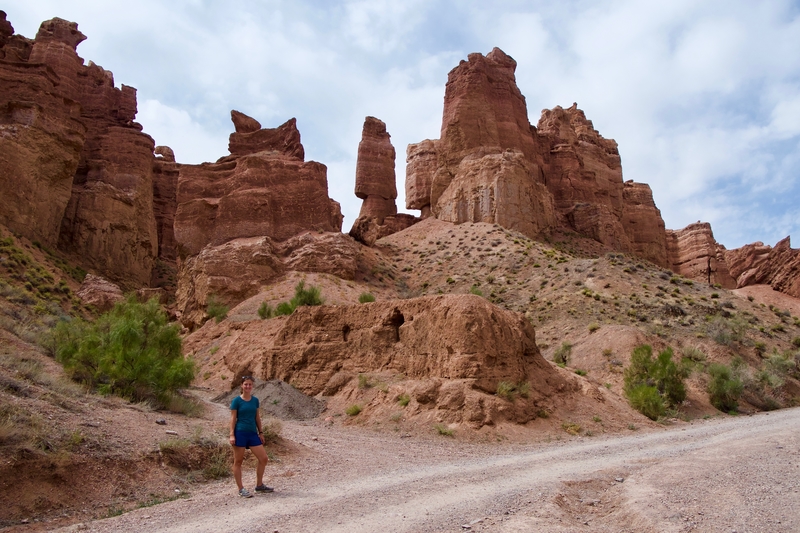
Though it is difficult to reach by public transport, the Charyn Canyon is one of the most popular sites in Kazakhstan. For more than twelve million years, wind, water and sand have sculpted the Charyn’s orange-hued cliffs.Resembling parts of Utah and Arizona, the canyon adds dimension and color to the endless steppe that surrounds it in all directions.
The Charyn Canyon consists of five distinct areas: the Yellow Canyon, the Temirlik Canyon, the Bestamak Canyon, the Red Canyon and the popular Valley of Castles. The Valley of Castles is the most famous part of the park and the only section that we visited on our tour from Almaty.
Our driver, Ivan, dropped us at the parking lot near the canyon rim and instructed us to walk along the valley floor until we reached the Charyn River. The leisurely hike is about two miles each way and affords dramatic views of the towering red sandstone.
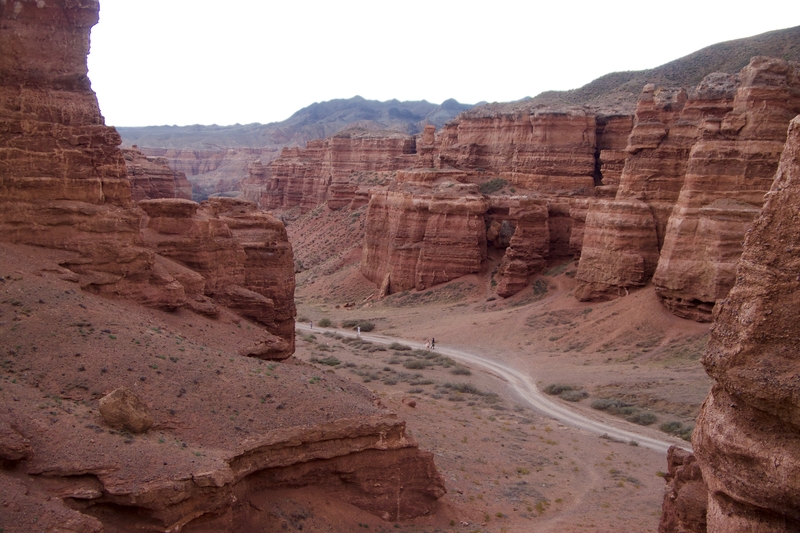
From the Charyn Canyon, we left the Kazakh Steppe behind and ventured into the foothills of the Tian Shan Mountains. Our destination was Lake Kaindy–a spectacular blue-green lake that is home to Kazakhstan’s ‘inverted forest.’
Kaindy Lake is surrounded by dense, pine-covered woods. Though just a short drive from the Charyn Canyon, the area’s alpine scenery made me feel like I had been transported back home, to the Pacific Northwest.
Kaindy Lake’s elegant trees rise gracefully from the shallow lake, like the masts of sunken ships. The unique lake was formed in 1911, after an earthquake caused the ground to collapse in on itself. Water subsequently flooded the basin, submerging the existing forest. Due to its cold temperature, Kaindy Lake’s underwater forest has been preserved for over a century.

From the parking lot, we hiked along the short trail to the water’s edge. There, we spent a bit of time photographing the curious trees and watching a group of local fishermen.
A second short trail from the parking lot wraps around the lake and affords views of the skeletal trees from above.
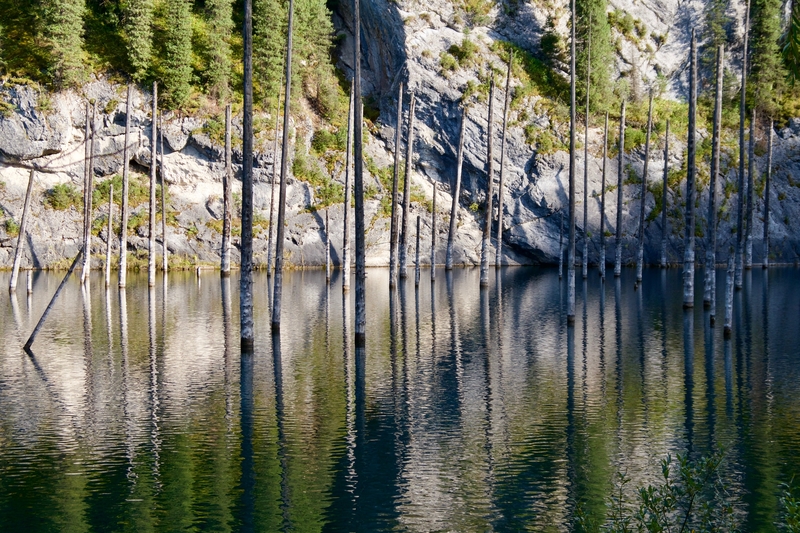
Kaindy Lake lies at the end of a dirt road that is only accessibly by four wheel drive. Despite being one of Kazakhstan’s most iconic attractions, its remote location and inaccessibility means that this wonder of nature can be enjoyed in relative quiet.
Day 3: Hiking the Kolsai Lakes Trail
The following morning, we left our homestay in Saty and headed toward the jewel-like Kolsai Lakes near the Kyrgyzstan border.
The two lower lakes–unimaginatively named Kolsai 1 and Kolsai 2–are surrounded by spruce trees, alpine meadows and mountain pastures. We spent much of our third day in Kazakhstan hiking between these two stunning alpine lakes.
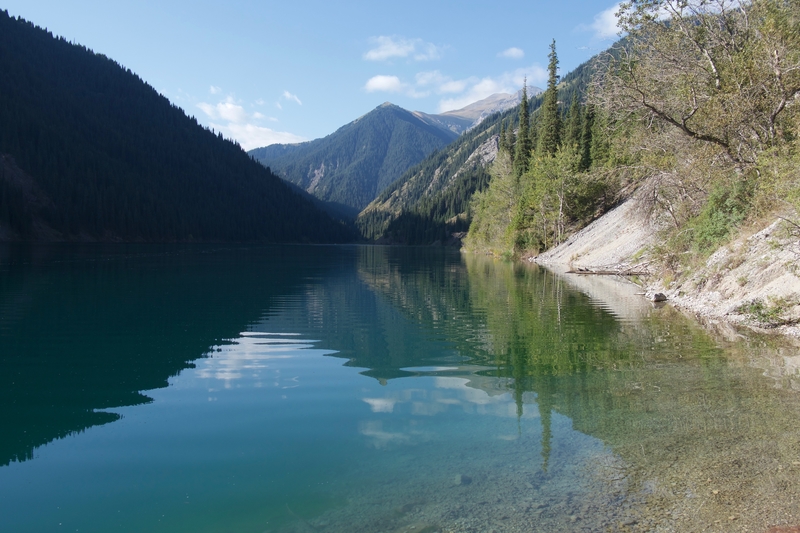
The lovely day hike between Kolsai 1 and Kolsai 2 winds through alpine forests and flower-speckled countryside. The path begins along the eastern lakeshore of Kolsai 1 and affords stunning views of the glassy blue-green water below. After a few miles of gradual incline along lakeside meadows, the path climbs to an altitude of 2,500 meters. The moderately difficult hike is approximately 18km roundtrip and takes about six hours to complete.
Due to its proximity to the Kyrgyz border, guards patrol the area around the Kolsai Lakes. We were made to show our passports both before the hike and after reaching Kolsai 2. Hiking to Kolsai 3 is currently forbidden, since the lake straddles Kazakhstan’s border with Kyrgyzstan.
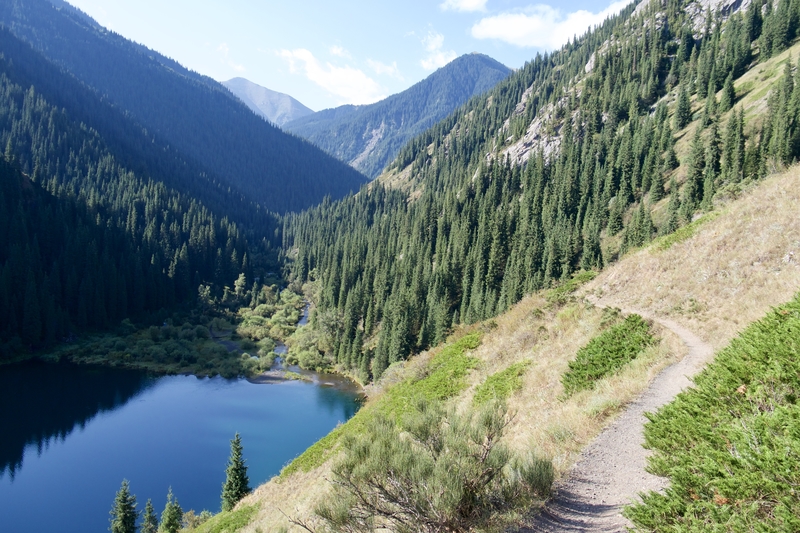
Our visit to the Kolsai Lakes coincided with Kazakhstan’s Labor Day. As a result, busloads of young Kazakh hikers descended upon the mountain in order to complete the hike between Kolsai 1 and Kolsai 2. The Kazakh hikers were friendly, outgoing and curious as to why we had decided to visit their country.
While I normally would be disappointed to encounter such crowds in an isolated location, the affable Kazakh backpackers we met made our hike to the Kolsai Lakes all the more enjoyable.
Day 4: Altyn Emel National Park and Tamgaly-Tas
After two days of visiting rock canyons and jewel-studded lakes, we spent our last day in Kazakhstan soaking in the sweeping emptiness of Altyn Emel National Park. Kazakhstan’s largest national park is vast, untouched and off-the-beaten-path. Driving down the solitary roads in Altyn Emel reminded me of traversing parts of Namibia–where cars are few and far between and wide-open vistas give the sense utter solitude.
I could have easily spent the entirety of my four day Kazakhstan itinerary in Altyn Emel National Park–home to towering dunes, colorful mountains, petroglyphs, ancient burial mounds and abundant wildlife. The 4,600 square mile park is simply too expansive to see in one day.
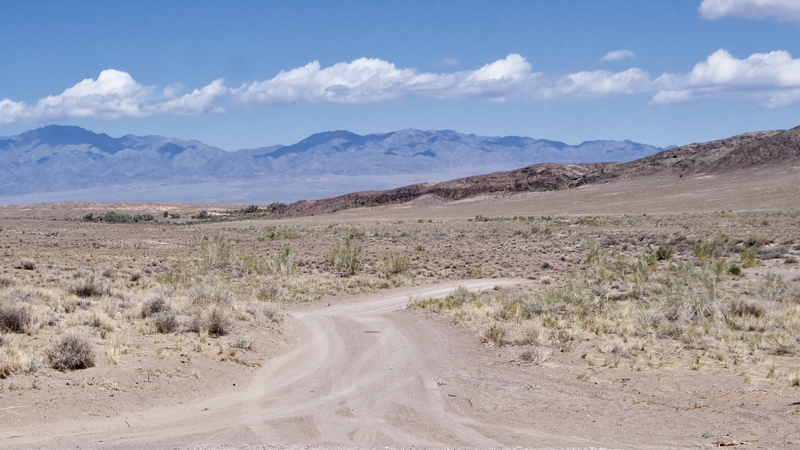
With only one morning in Altyn Emel, we limited our visit to the Singing Sand Dune.
The Singing Dune at Altyn Emel National Park is 1.5 kilometers long and 120 meters high. The dune get its name from the deep humming sound that occurs from vibrations when wind blows the top layers of sand. Recent rainfall meant that the dune was pretty quiet on the day we visited, but we were still able to hear the rumbling sound when we moved our hands and feet across the surface of the sand.
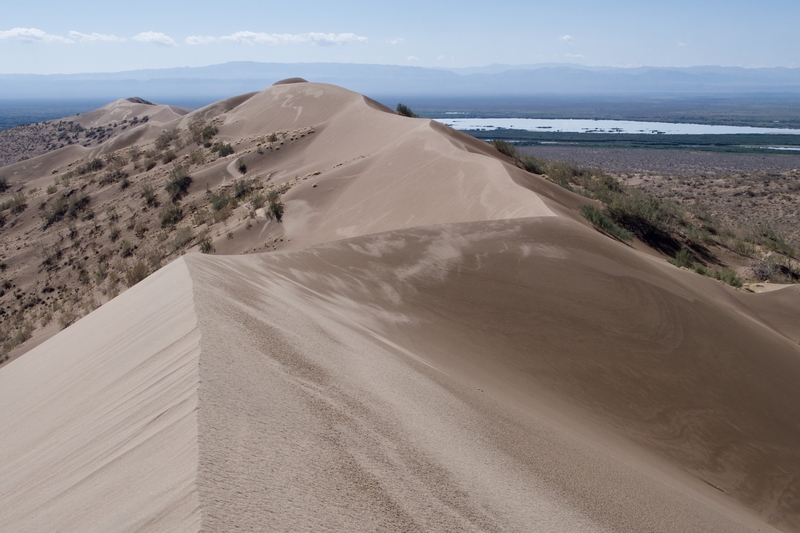
After running down the sand dune and gawking at its melodious hum, we made our way back to Almaty for the conclusion of our four day Kazakhstan itinerary. Along the way, Ivan dropped us off at one last stop–the mysterious petroglyphs of Tamgaly Tas (not to be confused with the UNESCO-recognized Tamgaly Petroglyphs that lie over 300 kilometers to the west).
The Tamgaly-Tas rock carvings date back to the fourteenth century and constitute an open-air Buddhist temple of sorts. The carved rocks lie on the banks of the Ili River, about 170 kilometers from Almaty. The decorated rocks contain images of the Buddha, as well as Tibetan inscriptions. The largest composition consists of three carved Buddhas, sitting on lotus flowers.
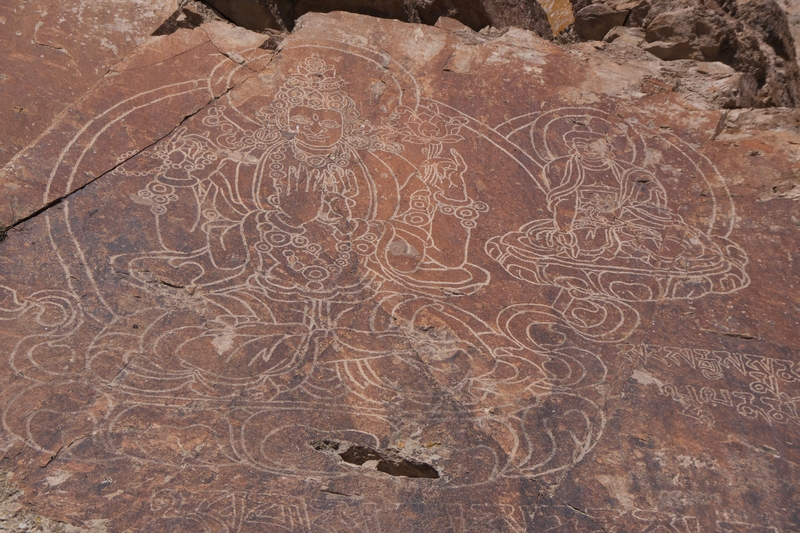
The rock carvings are sophisticated, intricate and beautiful.
***
Our four day Kazakhstan itinerary gave us a unique and varied sampling of some of Kazakhstan’s most beautiful places.
Now, when I think of Central Asia’s largest country, I no longer envision a blank spot on the map. Nor do I equate Kazakhstan to oil reserves and Borat.
Instead, I visualize glistening alpine lakes, canyons of chiseled red rock, and endless steppe–stretching as far as the eye can see–beneath cavernous blue skies.


